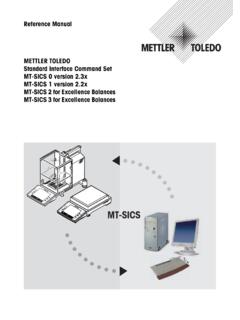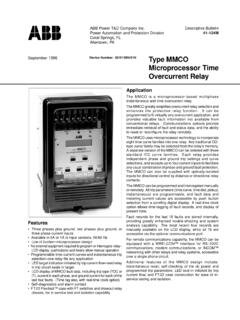Transcription of Configuring SPAN and RSPAN - cisco.com
1 CH A P T E R 23. Configuring SPAN and RSPAN . This chapter describes how to configure Switched Port Analyzer (SPAN) and Remote SPAN ( RSPAN ). on the Catalyst 2960 switch . Note For complete syntax and usage information for the commands used in this chapter, see the command reference for this release. This chapter consists of these sections: Understanding SPAN and RSPAN , page 23-1. Configuring SPAN and RSPAN , page 23-9. Displaying SPAN and RSPAN Status, page 23-22. Understanding SPAN and RSPAN . You can analyze network traffic passing through ports or VLANs by using SPAN or RSPAN to send a copy of the traffic to another port on the switch or on another switch that has been connected to a network analyzer or other monitoring or security device. SPAN copies (or mirrors) traffic received or sent (or both) on source ports or source VLANs to a destination port for analysis.
2 SPAN does not affect the switching of network traffic on the source ports or VLANs. You must dedicate the destination port for SPAN use. Except for traffic that is required for the SPAN or RSPAN session, destination ports do not receive or forward traffic. Only traffic that enters or leaves source ports or traffic that enters or leaves source VLANs can be monitored by using SPAN; traffic routed to a source VLAN cannot be monitored. For example, if incoming traffic is being monitored, traffic that gets routed from another VLAN to the source VLAN. cannot be monitored; however, traffic that is received on the source VLAN and routed to another VLAN. can be monitored. You can use the SPAN or RSPAN destination port to inject traffic from a network security device. For example, if you connect a cisco Intrusion Detection System (IDS) sensor appliance to a destination port, the IDS device can send TCP reset packets to close down the TCP session of a suspected attacker.
3 Catalyst 2960 switch Software Configuration Guide OL-8603-04 23-1. Chapter 23 Configuring SPAN and RSPAN . Understanding SPAN and RSPAN . These sections contain this conceptual information: Local SPAN, page 23-2. Remote SPAN, page 23-2. SPAN and RSPAN Concepts and Terminology, page 23-3. SPAN and RSPAN Interaction with Other Features, page 23-8. Local SPAN. Local SPAN supports a SPAN session entirely within one switch ; all source ports or source VLANs and destination ports are in the same switch . Local SPAN copies traffic from one or more source ports in any VLAN or from one or more VLANs to a destination port for analysis. For example, in Figure 23-1, all traffic on port 5 (the source port) is mirrored to port 10 (the destination port). A network analyzer on port 10receives all network traffic from port 5 without being physically attached to port 5.
4 Figure 23-1 Example of Local SPAN Configuration on a Single switch Port 5 traffic mirrored 1 2 3 4 5 6 7 8 9 10 11 12 on Port 10. 6 7. 5 8 11. 4 9 12. 3 10. 2. 1. 43580. Network analyzer Remote SPAN. RSPAN supports source ports, source VLANs, and destination ports on different switches, enabling remote monitoring of multiple switches across your network. Figure 23-2 shows source ports on switch A and switch B. The traffic for each RSPAN session is carried over a user-specified RSPAN VLAN that is dedicated for that RSPAN session in all participating switches. The RSPAN traffic from the source ports or VLANs is copied into the RSPAN VLAN and forwarded over trunk ports carrying the RSPAN . VLAN to a destination session monitoring the RSPAN VLAN. Each RSPAN source switch must have either ports or VLANs as RSPAN sources. The destination is always a physical port, as shown on switch C in the figure.
5 Catalyst 2960 switch Software Configuration Guide 23-2 OL-8603-04. Chapter 23 Configuring SPAN and RSPAN . Understanding SPAN and RSPAN . Figure 23-2 Example of RSPAN Configuration RSPAN . destination ports RSPAN . switch C. destination session Intermediate switches must support RSPAN VLAN. RSPAN . VLAN. switch A switch B. RSPAN RSPAN . source source session A session B. 101366. RSPAN RSPAN . source ports source ports SPAN and RSPAN Concepts and Terminology This section describes concepts and terminology associated with SPAN and RSPAN configuration. SPAN Sessions SPAN sessions (local or remote) allow you to monitor traffic on one or more ports, or one or more VLANs, and send the monitored traffic to one or more destination ports. A local SPAN session is an association of a destination port with source ports or source VLANs, all on a single network device.
6 Local SPAN does not have separate source and destination sessions. Local SPAN sessions gather a set of ingress and egress packets specified by the user and form them into a stream of SPAN data, which is directed to the destination port. RSPAN consists of at least one RSPAN source session, an RSPAN VLAN, and at least one RSPAN . destination session. You separately configure RSPAN source sessions and RSPAN destination sessions on different network devices. To configure an RSPAN source session on a device, you associate a set of source ports or source VLANs with an RSPAN VLAN. The output of this session is the stream of SPAN. packets that are sent to the RSPAN VLAN. To configure an RSPAN destination session on another device, you associate the destination port with the RSPAN VLAN. The destination session collects all RSPAN VLAN traffic and sends it out the RSPAN destination port.
7 Catalyst 2960 switch Software Configuration Guide OL-8603-04 23-3. Chapter 23 Configuring SPAN and RSPAN . Understanding SPAN and RSPAN . An RSPAN source session is very similar to a local SPAN session, except for where the packet stream is directed. In an RSPAN source session, SPAN packets are relabeled with the RSPAN VLAN ID and directed over normal trunk ports to the destination switch . An RSPAN destination session takes all packets received on the RSPAN VLAN, strips off the VLAN. tagging, and presents them on the destination port. Its purpose is to present a copy of all RSPAN VLAN. packets (except Layer 2 control packets) to the user for analysis. There can be more than one source session and more than one destination session active in the same RSPAN VLAN. There can also be intermediate switches separating the RSPAN source and destination sessions.
8 These switches need not be capable of running RSPAN , but they must respond to the requirements of the RSPAN VLAN (see the RSPAN VLAN section on page 23-7). Traffic monitoring in a SPAN session has these restrictions: Sources can be ports or VLANs, but you cannot mix source ports and source VLANs in the same session. The switch supports up to two source sessions (local SPAN and RSPAN source sessions). You can run both a local SPAN and an RSPAN source session in the same switch . The switch supports a total of 66 source and RSPAN destination sessions. You can have multiple destination ports in a SPAN session, but no more than 64 destination ports. You can configure two separate SPAN or RSPAN source sessions with separate or overlapping sets of SPAN source ports and VLANs. SPAN sessions do not interfere with the normal operation of the switch .
9 However, an oversubscribed SPAN destination, for example, a 10-Mb/s port monitoring a 100-Mb/s port, can result in dropped or lost packets. When RSPAN is enabled, each packet being monitored is transmitted twice, once as normal traffic and once as a monitored packet. Therefore monitoring a large number of ports or VLANs could potentially generate large amounts of network traffic. You can configure SPAN sessions on disabled ports; however, a SPAN session does not become active unless you enable the destination port and at least one source port or VLAN for that session. The switch does not support a combination of local SPAN and RSPAN in a single session. That is, an RSPAN source session cannot have a local destination port, an RSPAN destination session cannot have a local source port, and an RSPAN destination session and an RSPAN source session that are using the same RSPAN VLAN cannot run on the same switch .
10 Monitored Traffic SPAN sessions can monitor these traffic types: Receive (Rx) SPAN The goal of receive (or ingress) SPAN is to monitor as much as possible all the packets received by the source interface or VLAN before any modification or processing is performed by the switch . A copy of each packet received by the source is sent to the destination port for that SPAN session. Packets that are modified because of routing or quality of service (QoS) for example, modified Differentiated Services Code Point (DSCP) are copied before modification. Features that can cause a packet to be dropped during receive processing have no effect on ingress SPAN; the destination port receives a copy of the packet even if the actual incoming packet is dropped. These features include IP standard and extended input access control lists (ACLs), ingress QoS policing, and egress QoS policing.











